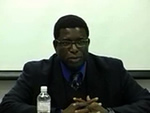Robert Young’s, “Putting Materialism back into Race Theory” argues that “the recent work by African-American humanists, or discourse theorists, or even left-liberal intellectuals, these various groups—despite their intellectual differences—form a ruling coalition and one thing is clear: capitalism set the limit for political change, as there is no alternative to the rule of capital. In contrast to much of contemporary race theory, a transformative theory of race highlights the political economy of race in the interests of an emancipatory political project.” Explain his argument and flesh out his critiques of Asante, Mills, Goldberg, Collins, et al. Put in your own words what his theory of race entails and how it leads to a different kind of political work.
See also his “Postpositivist Realism and the return of the Same: The Rational Subject and the Post(post)modern Liberalism.” Cultural Logic (2002): 39 pars. 15 November 2002.
Dr. Robert M. Young, professor of English in the College of Arts and Sciences at the University of Alabama, passed away Sunday, Jan. 31, 2010, after a four year battle with cancer.
 HEGEL
HEGEL  EZE
EZE  FYI, see
FYI, see